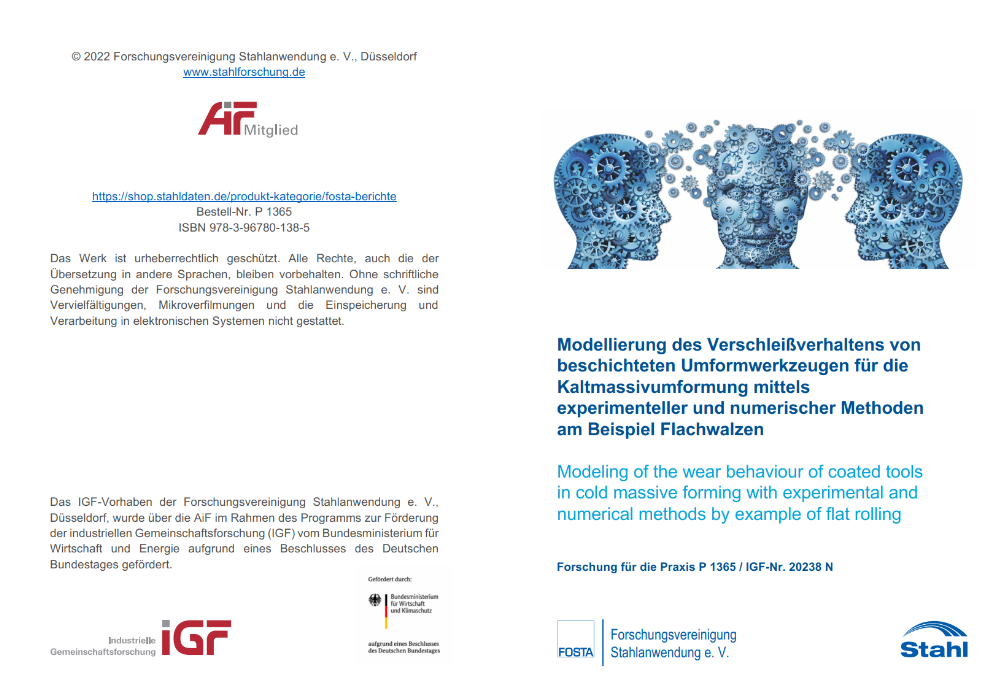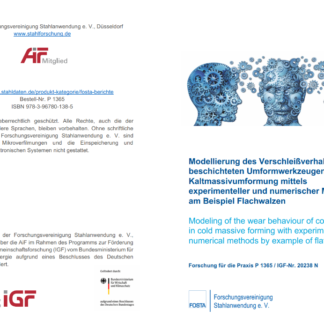Description
P 1365 – Modeling of the wear behaviour of coated tools in cold massive forming with experimental and numerical methods by example of flat rolling
Hot and cold forming leads to high tool wear due to thermal and mechanical alternating stresses. One way to reduce wear is to coat the forming tools. However, the effort required for the experimental development of new wear-protective coatings is immense for SMEs, as there is currently no known methodology for quantifying the wear resistance and adhesive strength of metal coatings on forming tools.
The aim of the research project was to develop an experimental and numerical methodology for evaluating wear-resistant coatings on forming tools under the specific process parameters of cold rolling steel strip. To achieve this, process models were built at macro and meso levels to calculate the load spectra, and methods were developed to determine the adhesion strength and fatigue of the coating on the forming tool. The commonly used hard chrome with coating thicknesses of 20 µm and 50 µm and the potentially also useful electroless nickel with a coating thickness of 20 µm were selected as roll coatings.
The adhesive shear strength of the electroless nickel coating was determined for the first time using a newly developed microadhesive shear test by shearing deposited electroless nickel microstructures to 315 MPa with a nanoindenter. The influence of cyclic loading on coating failure was also investigated using the nanoindenter. A significant influence of cyclic loading in the normal direction is not evident. However, the risk of delamination of the Ni coating increases significantly with the number of lateral loading cycles. Since the adhesive strength of the Cr coating could not be determined experimentally, adhesive strength values from literature were used for the simulation.
The two-stand industrial cold rolling process was simulated with the macro model. The rolling force determined in operation was accurately reproduced with the macro model. ased on a parameter study at the meso level, the delamination risk under the calculated loads in the rolling gap can be assessed as relatively high for the nickel layer and low for the chromium layer. Furthermore, a semi-empirical wear model for the Ni coating was created by means of simulation. According to this model, delamination should occur after 165,000 working cycles.
For the validation of the method, a 3-roll wear test bench was set up and operated under loads as similar as possible to those in the cold rolling process. Delamination of the electroless nickel or the chromium layers from the work rolls could not be detected even after a high number of 500,000 load cycles. In the case of the 20 µm and 50 µm chromium layers, this is in agreement with the simulation results. However, the simulation results predicting delamination of the nickel layer after about 165,000 loads cannot be confirmed experimentally. One reason for this could be that the tensile and shear bond strengths as input parameters for the simulation cannot yet be determined experimentally with sufficient accuracy.
All research reports in german language only!
Published in:
June 2022
Autors:
Dr. A. Bán, A. Tacke, Z. Liu, A. Quadfasel, Prof. Dr.-Ing. G. Hirt


